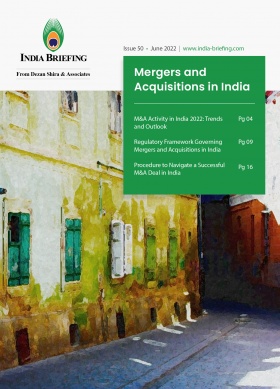Taxation of India’s Outbound Remittances: LRS Scheme and Increased Tax Rate from October 1
Effective from October 1, 2023, the tax rate on outbound remittances from India will rise from five percent to 20 percent. This increase will impact funds sent abroad for purposes such as vacations, investments, and gifts. The initial implementation date for this provision was July 1, but it was subsequently extended through a notification issued on June 28. However, it’s important to highlight that transactions equal to or below INR 700,000 made through international debit or credit cards will be exempted from the Liberalized Remittance Scheme (LRS scheme), as clarified on May 19, 2023. This article outlines the latest changes to India’s taxation of outbound remittances and addresses frequently asked questions about the LRS scheme. It must be noted that the LRS scheme is not accessible to corporates, partnerships, trusts, and similar entities.
Effective October 1, 2023, the Indian government has increased the tax on outbound remittances from five percent to 20 percent, as per the amended Income-tax Act, 1961. While exceptions apply to educational and medical expenses, the new tax rate will be applicable to funds sent overseas for vacations, investments, and gifts, if the amount exceeds INR 700,000 per financial year. Initially, this provision was scheduled to be effective from July 1, but through a notification issued on June 28, 2023, the federal government extended the deadline.
 Earlier on May 19, 2023, the Indian federal government also issued a clarification regarding the tax implications of outbound remittances for small transactions below INR 700,000 (US$8,500). According to the latest notification, any individual making payments using their international Debit or Credit cards up to INR 700,000 per financial year will be exempt from the Liberalized Remittance Scheme (LRS) limits. As a result, these transactions will not be subject to any Tax Collected at Source (TCS).
Earlier on May 19, 2023, the Indian federal government also issued a clarification regarding the tax implications of outbound remittances for small transactions below INR 700,000 (US$8,500). According to the latest notification, any individual making payments using their international Debit or Credit cards up to INR 700,000 per financial year will be exempt from the Liberalized Remittance Scheme (LRS) limits. As a result, these transactions will not be subject to any Tax Collected at Source (TCS).
This clarification has recently been issued to address concerns about procedural ambiguity. Earlier, the Finance Act 2023 had announced that all outbound remittances, irrespective of the amount, will be liable to tax.
According to financial experts, this move is aimed at making high-net-worth individuals (HNIs) pay their fair share before leaving India permanently. In the past five years, around 30,000-35,000 HNIs have migrated to countries such as the US, UK, UAE, Canada, Australia, Singapore, and Europe. This number was 8,000 in 2022 alone.
Webinar – Navigating Global Minimum Tax in Asia: Insights for Businesses
Thursday, November 16, 2023 | 9:00 AM San Francisco / 12:00 PM New York / 6:00 PM Brussels / 1:00 AM (Nov. 17th) Beijing
Partner Kyle Freeman will introduce how key Asian economies are implementing the new changes, how companies are going to be impacted by the OECD’s global minimum tax framework, and what businesses should be doing to be prepared.
Join us in this free webinar.
What are the revised tax rates for outbound remittances starting October 1, 2023?
|
Particulars |
Old tax rates applicable till September 30, 2023 |
New tax rates applicable from October 1, 2023 |
||
|---|---|---|---|---|
|
PAN is available |
PAN is unavailable |
PAN is available |
PAN is unavailable |
|
|
Overseas tour program (payment for purchase of ticket, booking hotel, etc.) |
5% of remittance amount |
10% of remittance amount |
20% of remittance amount in excess of INR 700,000 in a financial year |
40% of remittance amount in excess of INR 700,000 in a financial year |
|
LRS – for education and medical treatment |
5% of remittance amount in excess of INR 700,000 in a financial year |
10% of remittance amount in excess of INR 700,000 in a financial year |
5% of remittance amount in excess of INR 700,000 in a financial year |
10% of remittance amount in excess of INR 700,000 in a financial year |
|
Remittance related to studies abroad, where source of fund is educational loan |
0.5% of remittance amount in excess of INR 700,000 in a financial year |
5% of remittance amount in excess of INR 700,000 in a financial year |
0.5% of remittance amount in excess of INR 700,000 in a financial year |
5% of remittance amount in excess of INR 700,000 in a financial year |
|
LRS – other than education and medical treatment |
5% of remittance amount |
10% of remittance amount |
20% of remittance amount in excess of INR 700,000 in a financial year |
40% of remittance amount in excess of INR 700,000 in a financial year |
India’s Liberalized Remittance Scheme (LRS)
The Liberalized Remittance Scheme or LRS is a measure implemented by the Reserve Bank of India to make it easier for resident individuals to transfer funds outside India. The LRS scheme enables outbound remittance of up to US$250,000 per financial year (April to March) for any permissible current or capital account transaction or a combination of both.
FAQs on the LRS scheme
Can remittances be made only in US Dollars?
The remittances can be made in any freely convertible foreign currency.
Is there any restriction on number of remittances during a fiscal year?
There is no limit on the number of transactions that can be made within a fiscal year under the LRS scheme. However, the total amount of foreign exchange remitted through all sources in India should not exceed the LRS limit for the current fiscal year.
Who is eligible to remit funds outside India under LRS?
Resident individuals are eligible to remit funds outside India under the LRS scheme, subject to certain terms and conditions. The scheme is not available to corporates, partnership firms, trusts, etc. If the remitter is a minor, the LRS declaration form must be countersigned by the minor’s natural guardian.
Do resident individuals need to have a Permanent Account Number (PAN) for outbound remittances under the LRS scheme?
Yes, it is mandatory for resident individuals to provide their PAN for all transactions made under the LRS scheme through authorized persons.
Which transactions are prohibited under the LRS?
The Liberalized Remittance Scheme prohibits certain types of remittances, including:
- Remittances for any purpose that is specifically prohibited under Schedule-I, such as the purchase of lottery tickets, proscribed magazines, or any item restricted under Schedule-II of the Foreign Exchange Management (Current Account Transactions) Rules, 2000.
- Remittances from India for margins or margin calls to overseas exchanges or counterparties.
- Remittances for the purchase of Foreign Currency Convertible Bonds (FCCBs) issued by Indian companies in the overseas secondary market.
- Remittances for trading in foreign exchange abroad.
- Capital account remittances, directly or indirectly, to countries identified by the Financial Action Task Force (FATF) as “non-cooperative countries and territories”.
- Remittances, directly or indirectly, to individuals and entities identified by the RBI as posing significant risks of committing acts of terrorism.
- Additionally, the scheme does not permit gifting by a resident to another resident in foreign currency for credit to the latter’s foreign currency account held abroad under LRS.
Which current account transactions are allowed under the LRS?
Under the LRS, the following current account transactions are permissible:
- Private visits (excluding to Nepal and Bhutan)
- Gifts or donations, including rupee gifts, to Non-Resident Indians (NRIs) or Persons of Indian Origin (PIOs) who are close relatives
- Emigration
- Overseas business trips
- Medical treatment abroad
- Pursuing studies outside India
- Going abroad for employment
- Maintenance of close relatives abroad
It is important to note that the permissible current account transactions are subject to the overall limit of US$250,000 per financial year under the LRS.
Which capital account transactions are permissible under LRS?
The LRS allows the following capital account transactions:
- Opening a foreign currency account with a bank outside India
- Buying property abroad
- Investing in shares, securities, mutual funds, etc. overseas
- Establishing wholly owned subsidiaries (WOS) and joint ventures (JVs) outside India for legitimate business purposes subject to specified terms and conditions
- Providing INR loans to NRIs who are relatives as per the definition in the Companies Act, 2013.
Are resident individuals obligated to repatriate foreign investment income above principal amount under LRS?
Investors who have transferred funds under LRS can reinvest the income generated from their investments without any obligation to repatriate it. Nonetheless, any unused foreign exchange received or realized must be repatriated and surrendered to an authorized person within 180 days from the date of receipt, purchase, acquisition, or return to India, if not reinvested.
Moreover, any extra repatriation requirement concerning investments made under the Overseas Investments Rules and Regulations 2022 should also be complied with.
Is it possible to consolidate remittances for family members under the LRS?
Yes, remittances under the LRS facility can be consolidated for family members, provided that each family member adheres to the terms and conditions of the scheme. However, it is not permitted for other family members to club together for capital account transactions, such as investment and opening a bank account if they are not co-owners or co-partners of the overseas bank account or investment. In the case of acquiring immovable property outside India from a person residing outside India, remittances can be consolidated for relatives if such relatives, who are residents in India, comply with the terms and conditions of the scheme.
Permissibility of remittances: Should AD (Authorized Dealer) verify nature of transaction or rely on remitter’s declaration?
The AD (Authorized Dealer) is required to verify the permissibility of remittances based on the nature of the transaction as declared by the remitter in Form A2. The AD will then certify that the remittance is in accordance with the instructions issued by the RBI in this regard. However, the ultimate responsibility for compliance with the extant FEMA (Foreign Exchange Management Act) rules and regulations lies with the remitter.
What are the compliance requirements for a remitter under the LRS scheme?
- The remitter must designate a branch of an AD through which all capital account remittances under the scheme will be made. Additionally, the remitter must have maintained a bank account with the bank for at least one year prior to the remittance.
- If the remitter is a new customer, the AD must carry out due diligence on the opening, operation, and maintenance of the account. The AD must also obtain a bank statement or copies of the latest Income Tax Assessment Order or Return filed by the applicant to verify the source of funds.
- The remitter also needs to furnish Form A-2, declare that the funds belong to them, and confirm that the funds will not be used for purposes prohibited or regulated under the LRS scheme.
(This article was originally published on April 27, 2023 and last updated on June 29, 2023.)
About Us
India Briefing is produced by Dezan Shira & Associates. The firm assists foreign investors throughout Asia from offices across the world, including in Delhi and Mumbai. Readers may write to india@dezshira.com for more support on doing business in India.
We also maintain offices or have alliance partners assisting foreign investors in Indonesia, Singapore, Vietnam, Philippines, Malaysia, Thailand, Italy, Germany, and the United States, in addition to practices in Bangladesh and Russia.
- Previous Article An Introduction to Doing Business in India 2023 for EU Businesses – New Publication from Dezan Shira & Associates
- Next Article Maximizing Business Growth in India with PEOs as Strategic HR Partners








